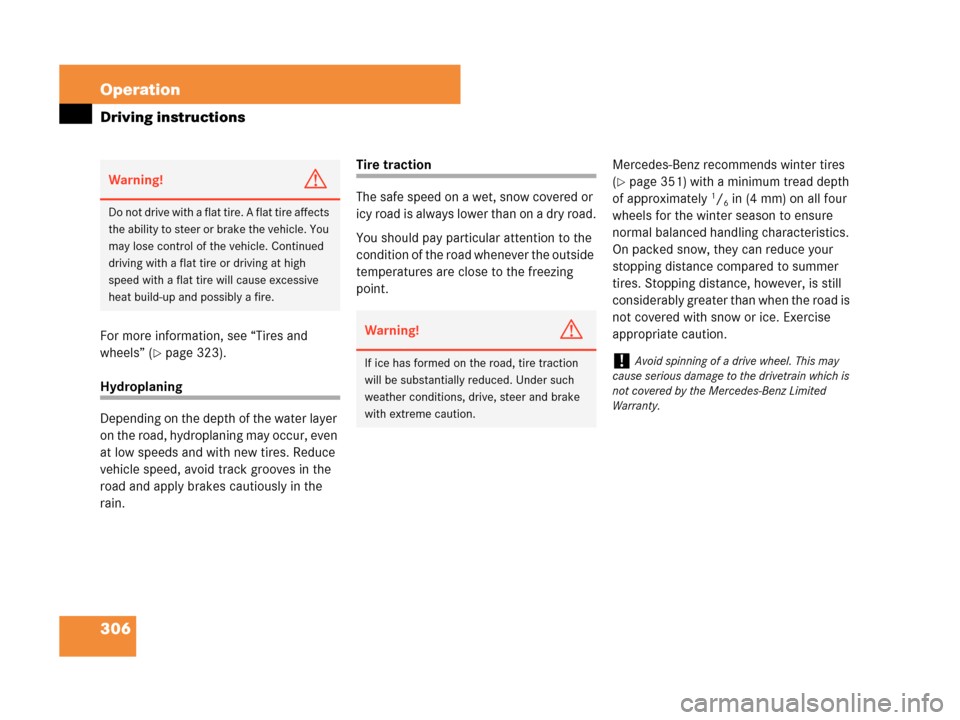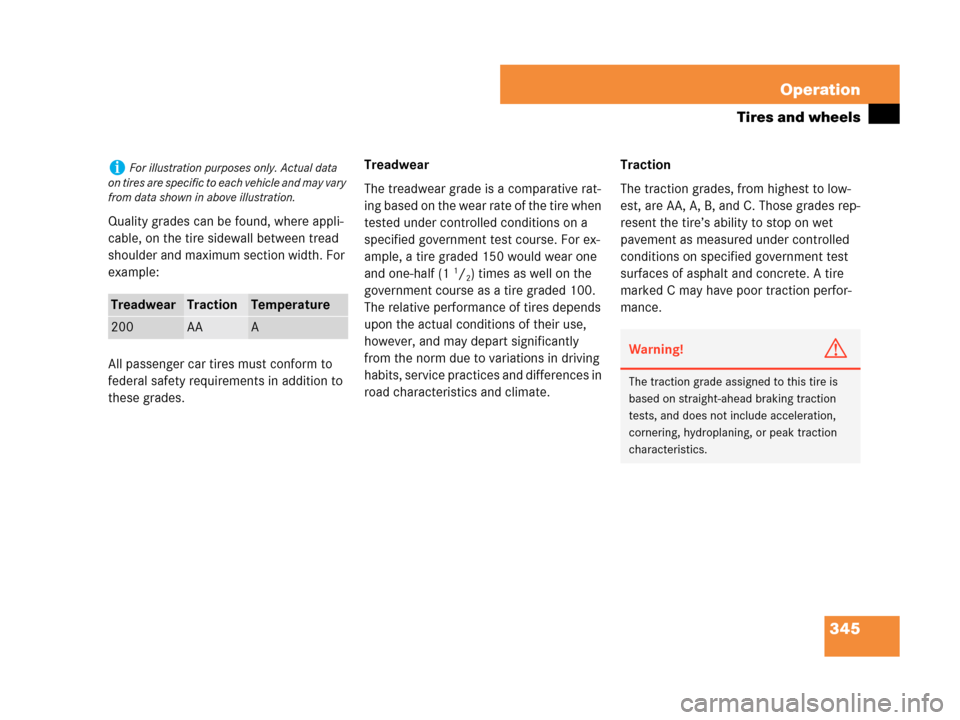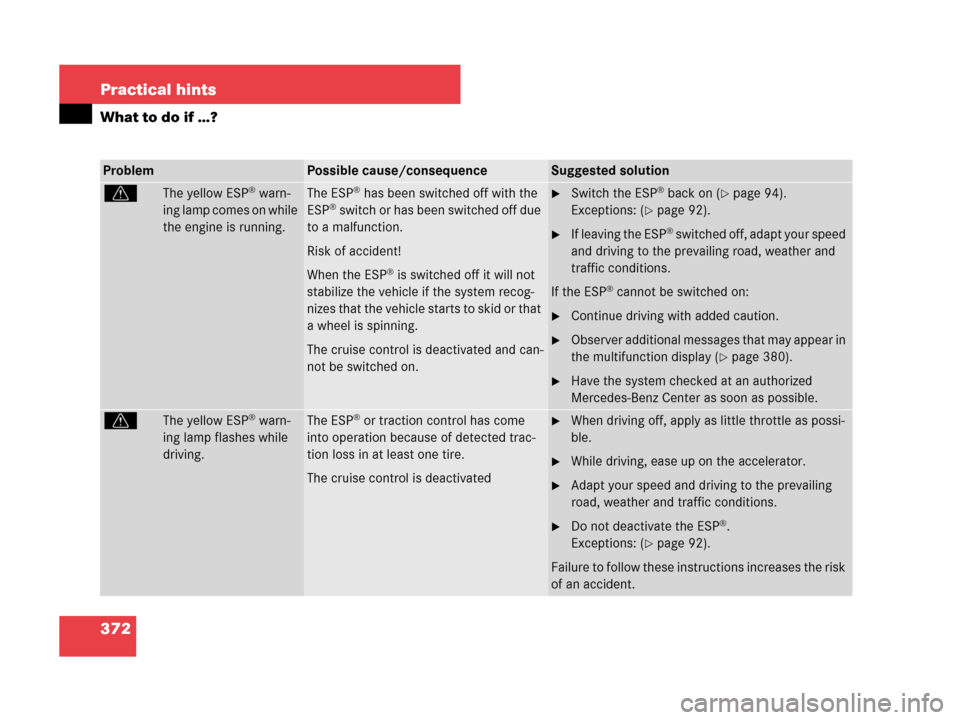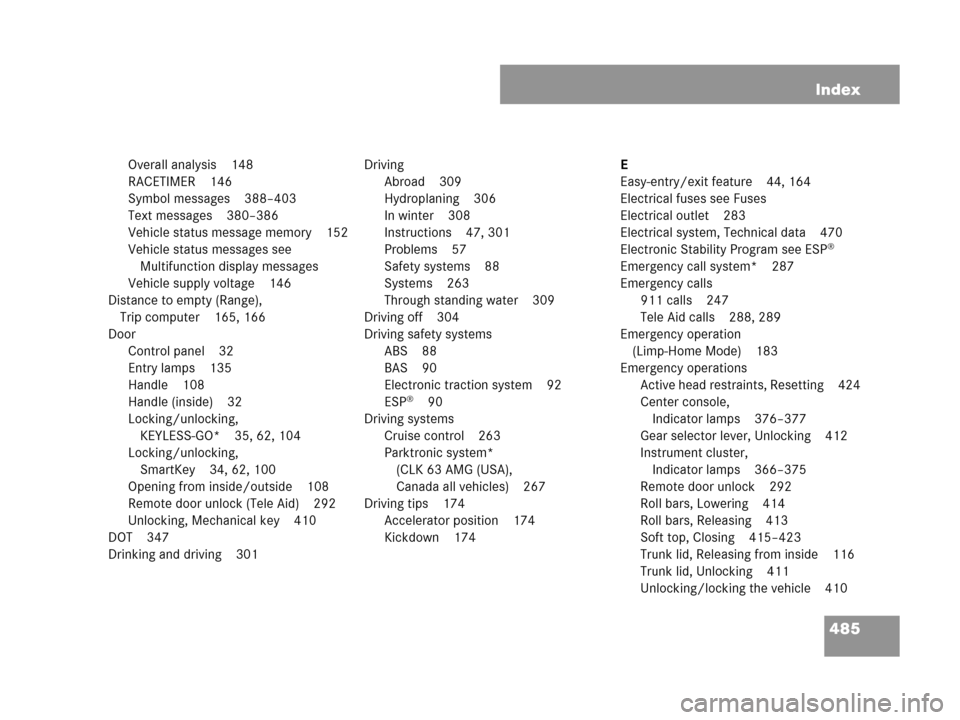Page 264 of 505

263 Controls in detail
Driving systems
�Driving systems
The driving systems of your vehicle are de-
scribed on the following pages:
�Cruise control, with which the vehicle
can maintain a preset speed.
�Parktronic* (CLK 63 AMG (USA),
Canada all vehicles), which serves as a
parking assistant.
For information on the BAS, ABS, and
ESP
®, see “Driving safety systems”
(
�page 88).
Cruise control
Cruise control automatically maintains the
speed you set for your vehicle.
Use of cruise control is recommended for
driving at a constant speed for extended
periods of time.
You can set or resume cruise control at any
speed over 20 mph (30 km/h).
The cruise control function is operated by
means of the cruise control lever.
The cruise control lever is the uppermost
lever on the left-hand side of the steering
column (
�page 24).
Warning!G
Cruise control is a convenience system de-
signed to assist the driver during vehicle op-
eration. The driver is and must always
remain responsible for the vehicle’s speed
and for safe brake operation.
Only use cruise control if the road, traffic
and weather conditions make it advisable to
travel at a steady speed.
�The use of cruise control can be danger-
ous on winding roads or in heavy traffic
because conditions do not allow safe
driving at a steady speed.
�The use of cruise control can be danger-
ous on slippery roads. Rapid changes in
tire traction can result in wheel spin and
loss of control.
�Deactivate cruise control when driving
in fog.
The “Resume” function should only be oper-
ated if the driver is fully aware of the previ-
ously set speed and wishes to resume this
particular preset speed.
Page 307 of 505

306 Operation
Driving instructions
For more information, see “Tires and
wheels” (
�page 323).
Hydroplaning
Depending on the depth of the water layer
on the road, hydroplaning may occur, even
at low speeds and with new tires. Reduce
vehicle speed, avoid track grooves in the
road and apply brakes cautiously in the
rain.
Tire traction
The safe speed on a wet, snow covered or
icy road is always lower than on a dry road.
You should pay particular attention to the
condition of the road whenever the outside
temperatures are close to the freezing
point.Mercedes-Benz recommends winter tires
(
�page 351) with a minimum tread depth
of approximately 1/6in (4 mm) on all four
wheels for the winter season to ensure
normal balanced handling characteristics.
On packed snow, they can reduce your
stopping distance compared to summer
tires. Stopping distance, however, is still
considerably greater than when the road is
not covered with snow or ice. Exercise
appropriate caution.
Warning!G
Do not drive with a flat tire. A flat tire affects
the ability to steer or brake the vehicle. You
may lose control of the vehicle. Continued
driving with a flat tire or driving at high
speed with a flat tire will cause excessive
heat build-up and possibly a fire.
Warning!G
If ice has formed on the road, tire traction
will be substantially reduced. Under such
weather conditions, drive, steer and brake
with extreme caution.!Avoid spinning of a drive wheel. This may
cause serious damage to the drivetrain which is
not covered by the Mercedes-Benz Limited
Warranty.
Page 346 of 505

345 Operation
Tires and wheels
Quality grades can be found, where appli-
cable, on the tire sidewall between tread
shoulder and maximum section width. For
example:
All passenger car tires must conform to
federal safety requirements in addition to
these grades.Treadwear
The treadwear grade is a comparative rat-
ing based on the wear rate of the tire when
tested under controlled conditions on a
specified government test course. For ex-
ample, a tire graded 150 would wear one
and one-half (1
1/2) times as well on the
government course as a tire graded 100.
The relative performance of tires depends
upon the actual conditions of their use,
however, and may depart significantly
from the norm due to variations in driving
habits, service practices and differences in
road characteristics and climate.Traction
The traction grades, from highest to low-
est, are AA, A, B, and C. Those grades rep-
resent the tire’s ability to stop on wet
pavement as measured under controlled
conditions on specified government test
surfaces of asphalt and concrete. A tire
marked C may have poor traction perfor-
mance.
iFor illustration purposes only. Actual data
on tires are specific to each vehicle and may vary
from data shown in above illustration.
TreadwearTractionTemperature
200AAA
Warning!G
The traction grade assigned to this tire is
based on straight-ahead braking traction
tests, and does not include acceleration,
cornering, hydroplaning, or peak traction
characteristics.
Page 373 of 505

372 Practical hints
What to do if …?
ProblemPossible cause/consequenceSuggested solution
vThe yellow ESP® warn-
ing lamp comes on while
the engine is running.The ESP® has been switched off with the
ESP® switch or has been switched off due
to a malfunction.
Risk of accident!
When the ESP
® is switched off it will not
stabilize the vehicle if the system recog-
nizes that the vehicle starts to skid or that
a wheel is spinning.
The cruise control is deactivated and can-
not be switched on.
�Switch the ESP® back on (�page 94).
Exceptions: (
�page 92).
�If leaving the ESP® switched off, adapt your speed
and driving to the prevailing road, weather and
traffic conditions.
If the ESP
® cannot be switched on:
�Continue driving with added caution.
�Observer additional messages that may appear in
the multifunction display (
�page 380).
�Have the system checked at an authorized
Mercedes-Benz Center as soon as possible.
vThe yellow ESP® warn-
ing lamp flashes while
driving.The ESP® or traction control has come
into operation because of detected trac-
tion loss in at least one tire.
The cruise control is deactivated�When driving off, apply as little throttle as possi-
ble.
�While driving, ease up on the accelerator.
�Adapt your speed and driving to the prevailing
road, weather and traffic conditions.
�Do not deactivate the ESP®.
Exceptions: (
�page 92).
Failure to follow these instructions increases the risk
of an accident.
Page 486 of 505

485 Index
Overall analysis 148
RACETIMER 146
Symbol messages 388–403
Text messages 380–386
Vehicle status message memory 152
Vehicle status messages see
Multifunction display messages
Vehicle supply voltage 146
Distance to empty (Range),
Trip computer 165, 166
Door
Control panel 32
Entry lamps 135
Handle 108
Handle (inside) 32
Locking/unlocking,
KEYLESS-GO* 35, 62, 104
Locking/unlocking,
SmartKey 34, 62, 100
Opening from inside/outside 108
Remote door unlock (Tele Aid) 292
Unlocking, Mechanical key 410
DOT 347
Drinking and driving 301Driving
Abroad 309
Hydroplaning 306
In winter 308
Instructions 47, 301
Problems 57
Safety systems 88
Systems 263
Through standing water 309
Driving off 304
Driving safety systems
ABS 88
BAS 90
Electronic traction system 92
ESP
®90
Driving systems
Cruise control 263
Parktronic system*
(CLK 63 AMG (USA),
Canada all vehicles) 267
Driving tips 174
Accelerator position 174
Kickdown 174E
Easy-entry/exit feature 44, 164
Electrical fuses see Fuses
Electrical outlet 283
Electrical system, Technical data 470
Electronic Stability Program see ESP
®
Emergency call system* 287
Emergency calls
911 calls 247
Tele Aid calls 288, 289
Emergency operation
(Limp-Home Mode) 183
Emergency operations
Active head restraints, Resetting 424
Center console,
Indicator lamps 376–377
Gear selector lever, Unlocking 412
Instrument cluster,
Indicator lamps 366–375
Remote door unlock 292
Roll bars, Lowering 414
Roll bars, Releasing 413
Soft top, Closing 415–423
Trunk lid, Releasing from inside 116
Trunk lid, Unlocking 411
Unlocking/locking the vehicle 410